
Potchefstroom
Potchefstroom, or colloquially called Potch, a large town in the North-West province. It is on the banks of the Mooi River not far from where it enters the Vaal. Geo-position: 26.7147°S, 27.099°E, altitude 1351m. According to Wikipedia it had a population of 43000 in 2007.
History
The town is competing with Klerksdorp to be the oldest white settlement to the north of the Vaal river. Potchefstroom was first established in November 1838 on the banks of the Mooi River, about 11km to the north of the present town. The Voortrekker leader responsible for it was Hendrik Potgieter. The name of the town was derived from this leader. Heavy flooding occurred making the people reconsider the position and they moved downstream onto more solid ground at its present position in 1841.
It was the first place north of the Vaal that in 1864 was declared a municipality, although it took until 1868 before the first council was elected.
MW Pretorius house
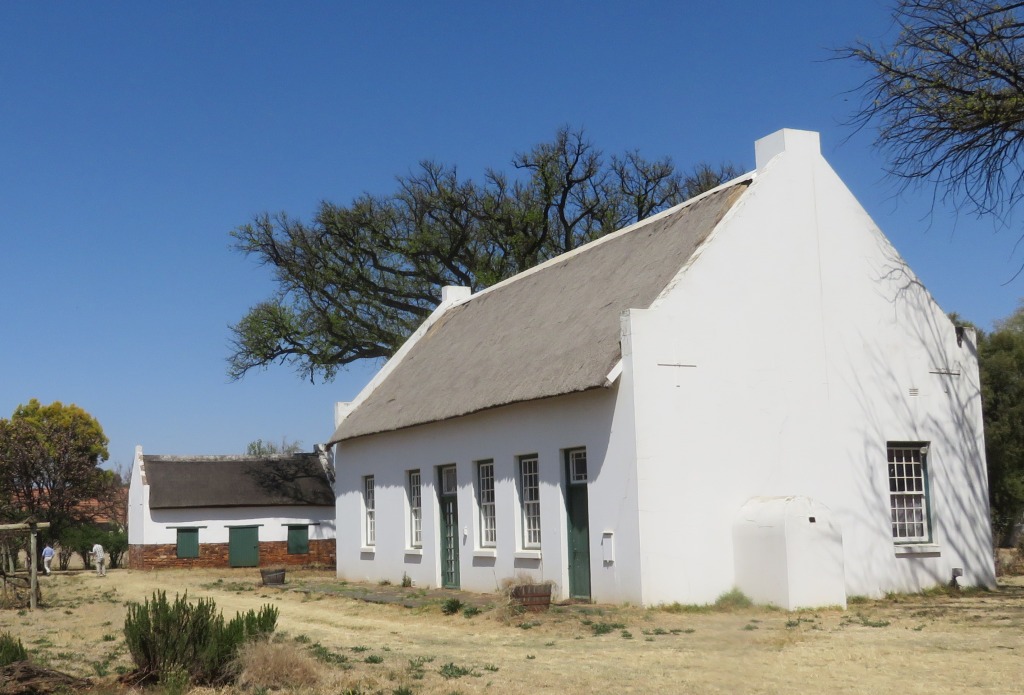
 Marthinus Wessels Pretorius built this house in a Cape Dutch style himself with one assistant, so it's written in the sources. He was the first president of the South African Republic (Zuid Afrikaanse Republik ZAR), appointed in 1857. There was no money available to pay him a salary, instead he received the farm Rietfontein as compensation. It was on this property that he constructed this house, plus some outbuildings. The main-house is believed to have been completed in 1868.
Marthinus Wessels Pretorius built this house in a Cape Dutch style himself with one assistant, so it's written in the sources. He was the first president of the South African Republic (Zuid Afrikaanse Republik ZAR), appointed in 1857. There was no money available to pay him a salary, instead he received the farm Rietfontein as compensation. It was on this property that he constructed this house, plus some outbuildings. The main-house is believed to have been completed in 1868.
Preceding this must have been the smithy, seen on the picture on the left to the left of the main building. It is not very certain but it fitted un well with his occupation, he was a wagon smith by trade, which involved a fair bit of iron work. I will be coming back to this smithy building later.
His presidency was not an easy one, there was trouble on many frontiers and a lack of money due to the fact that the burghers were reluctant to pay tax. He also occupied himself with trying to re-unify the two Boer republics, the ZAR and the Free State. At one point (1860 to 62) he had the presidency of both republics. He was not very successful in this endeavour, he had a strong opposition to his plans in both republics and it cost him the presidency of the ZAR and later of the Free State. But still he was re-appointed president of the ZAR and held this post until 1871. He had to resign because he was severely criticised for 'loosing' the diamond fields to Britain in the Keate Award.
The house is now a museum known as the MW Pretorius house. It contains some artefacts linked to Pretorius and is furnished in the style of the time.

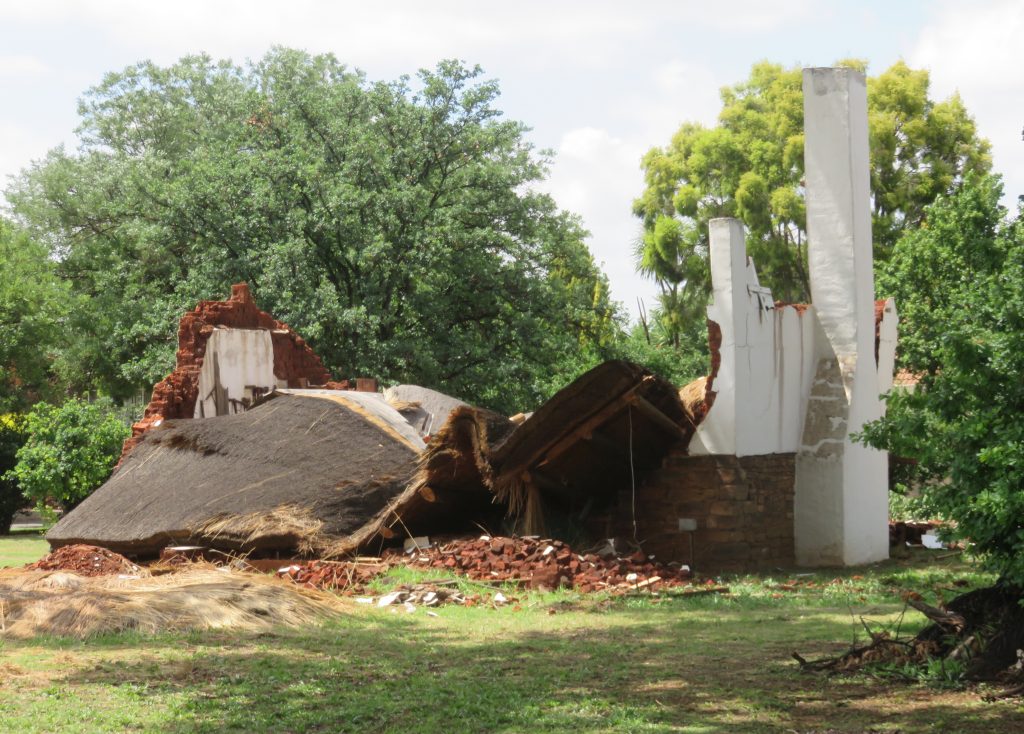
An other story is that of the smithy, the picture on the right shows the collapsed building. During our visit on the 13 September 2020 Johan noticed some new cracks in the walls and mentioned that he will have to get somebody to inspect and make proposals for stabilising the building. A few days later it collapsed over night. The question now is to rebuild or not. As in Pretorius's time , the state has no money, it will only be possible by a private initiative.
After resigning as president in 1871 he kept a low profile and came into short prominence again at the end of the 1st Boer War in 1881. He was one of the three leading members of the provisional government that led the Transvaal through the negotiations with the British to regain the independence of the ZAR.
 After that he totally withdrew from politics and lived until his death on 18 May 1901. He stayed in a house in Potchefstroom, put under house arrest by the British. At that time he did play a role in the peace committee set up to convince the Boers to relinquish the struggle.
After that he totally withdrew from politics and lived until his death on 18 May 1901. He stayed in a house in Potchefstroom, put under house arrest by the British. At that time he did play a role in the peace committee set up to convince the Boers to relinquish the struggle.
The monument with the commemorative plaque was erected in 1913 and unveiled by the Prime Minister Louise Botha. The translation of the inscription: Here rests; Marthinus; Wessel Pretorius; born at Pretorius Kloof district; Graaf Reinet 17 September 1819; died at Potchefstroom; 18 May 1901; state president of the South African Republic 1857-2860; of the Orange Free State 1860-1863; and of the South African Republic 1864-1871. The semicolons mark the line breaks.
Old Fort

 The fort was the scene of the Potchefstroom siege back in 1880/81 during the 1st Boer War. It started on 16 December 1880 when a group of Boers coming from the meeting at Paardekraal where the republic had been re- declared. They came to Potchefstroom to have the declaration printed by the Borelius printing works. This brought them into conflict with the British troops stationed in the town. The places they, the British, occupied was the magistrate and the telegraph office and the newly prepared fort just outside town. The position in town could not be held by the British and most of them retreated to the fort. The fort was besieged for 95 days, during that siege there were 213 British officers and men in the enclosure. There were also some civilians in the fort, those were British subjects who had been living in Potchefstroom.
The fort was the scene of the Potchefstroom siege back in 1880/81 during the 1st Boer War. It started on 16 December 1880 when a group of Boers coming from the meeting at Paardekraal where the republic had been re- declared. They came to Potchefstroom to have the declaration printed by the Borelius printing works. This brought them into conflict with the British troops stationed in the town. The places they, the British, occupied was the magistrate and the telegraph office and the newly prepared fort just outside town. The position in town could not be held by the British and most of them retreated to the fort. The fort was besieged for 95 days, during that siege there were 213 British officers and men in the enclosure. There were also some civilians in the fort, those were British subjects who had been living in Potchefstroom.
The siege was ended on the 21 March 1881, with the garison marching out of the fort and making their way to the Free State.

 The graveyard at the site of the hostilities contains the remains of the British troops and some civilians who lost their lives. Altogether there were 25 killed in action and 6 died from sickness on the British side. Casualties on the side of the Boers is not known. There is also a plaque in the Anglican Church commemorating the officers and soldiers who died during the siege.
The graveyard at the site of the hostilities contains the remains of the British troops and some civilians who lost their lives. Altogether there were 25 killed in action and 6 died from sickness on the British side. Casualties on the side of the Boers is not known. There is also a plaque in the Anglican Church commemorating the officers and soldiers who died during the siege.
Nothing of the original fort remains. The earth wall at the site indicates where the fort had been, it was put up at a later date.
Old Jail
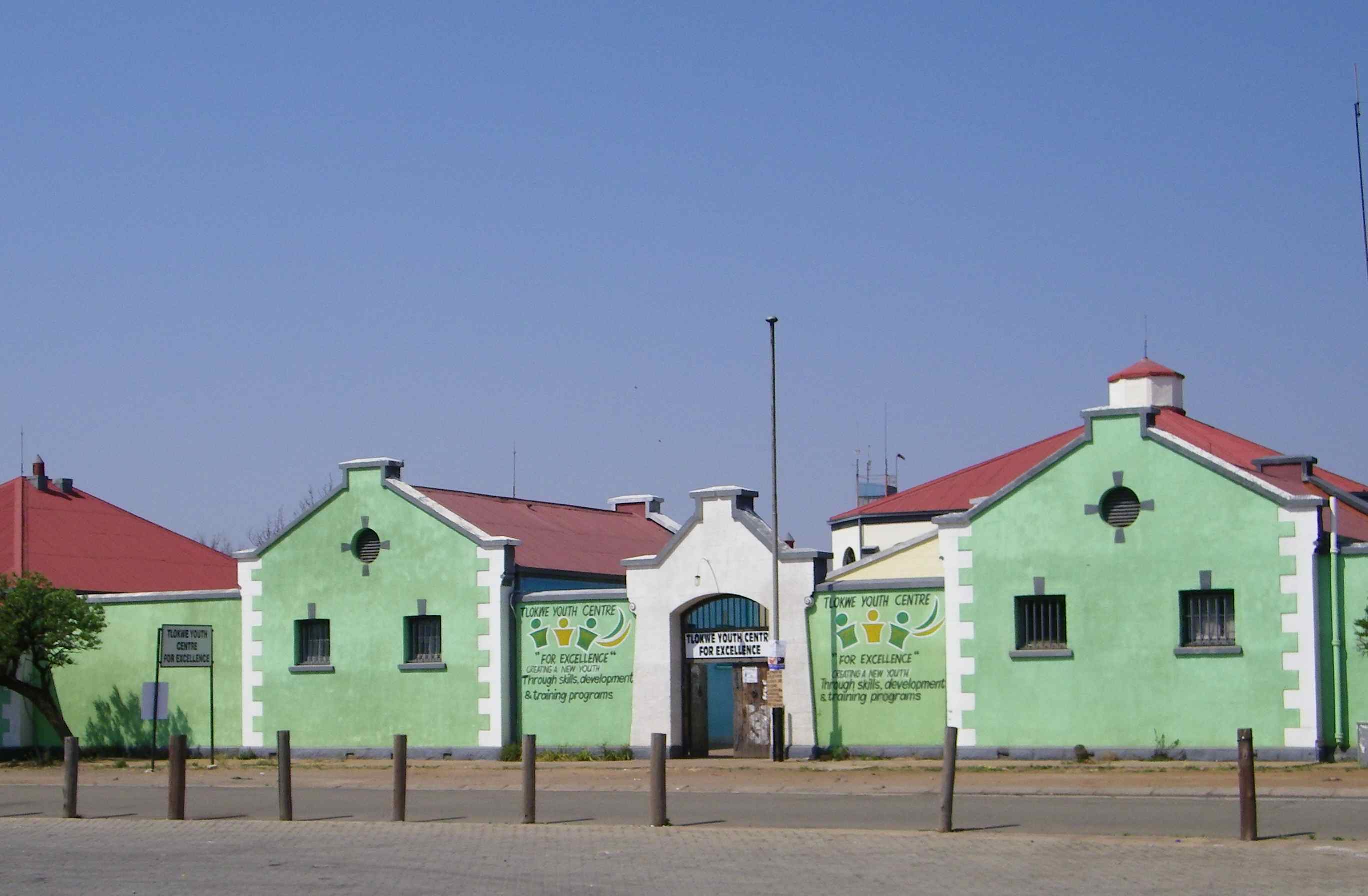
 The prison was built just before the outbreak of the Boer war in 1899. I am not sure for how long it was used as a prison, it later became the headquarters of the commando.
The prison was built just before the outbreak of the Boer war in 1899. I am not sure for how long it was used as a prison, it later became the headquarters of the commando.
When we first visited the place in 2011 people were living there, all the cells had been occupied. It seems to be organised, but by whom I don't know. During a later visit we were unable to enter at all, it was all locked and guarded.
Powder magazine
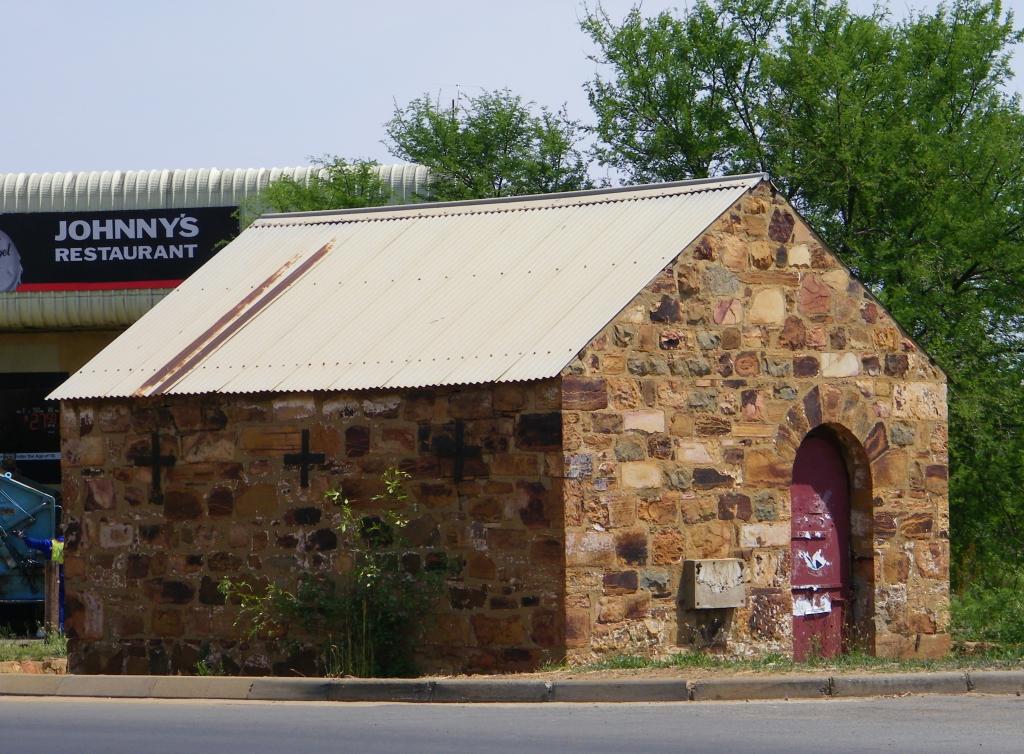 The first powder house, a place where gun powder is stored, was build between 1854 and 1857. It suffered severe damage when the British forces partially demolished it in 1880 to use the stones for the fort they were building nearby(see above about the old fort).
The first powder house, a place where gun powder is stored, was build between 1854 and 1857. It suffered severe damage when the British forces partially demolished it in 1880 to use the stones for the fort they were building nearby(see above about the old fort).
It was later completely demolished and a new building erected in 1898. It is one of the oldest buildings still standing in Potchefstroom, but not in use anymore to store gun powder.
Post and Telegraph building

 This imposing building not only housed the post office and the telegraph station, but also, according to the inscription, the landrost (magistrate).
This imposing building not only housed the post office and the telegraph station, but also, according to the inscription, the landrost (magistrate).
Railway Station
 The railway station building is no more, it burned down on the night of the 14 September 2020. Cause of the fire is unknown.
The railway station building is no more, it burned down on the night of the 14 September 2020. Cause of the fire is unknown.
The railway came to town back in 1897 when the NZASM company installed the rail link between Johannesburg and Kleksdorp, on which Potchefstroom is situated. NZASM stands for Nederlandsche Zuid-Afrikaanse Spoorwegmaatschappij, it was the company that had most of the rail lines installed in the old Zuid Afrikaanse Republik (ZAR). Their main project had been the railway line from Delagoa Bay (Maputo) to Pretoria.
In 1906 a connection was made from Klerksdorp through to Kimberley, it thus put Potchefstroom on the line to Cape Town. This justified a new station building.

 The foundation stone states that it was placed on the 1 May 1918.
The foundation stone states that it was placed on the 1 May 1918.
And now, as stated above it has burned down. The pictures were taken during November 2020.
Churches
Just a word on the history of the three Afrikaans or Dutch churches. There is the Nederduitse Gereformierde Kerk (NGK), the Nederduitsch Herformde Kerk (NHK) (both translated to English are the Dutch reformed church) and the Gereformierde Kerk. The NGK had its beginning in the Cape and came to its shores with Jan van Riebeeck. There was a problem with the Boers that went trekking from the Cape. The NGK did not support the emigration and refused to send theologians to assist the trekkers with church matters. On the other hand the trekkers did not really want the help from the Cape because that church had become part of the British administration. They were initially helped by Missionaries such as David Lindley. Potchefstroom particularly sent a request direct to Holland for support. The Gereformierde Kerk came out of the NHK, there were some differences involving the singing of hymns.
Nederduitsch Hervormde Kerk
 The oldest still standing church north of the Vaal River. Building started in 1859 and was completed in 1866.
The oldest still standing church north of the Vaal River. Building started in 1859 and was completed in 1866.
Before that there was a small church that had been build in 1842 after a collection was held amongst the trekkers. During the 1850's a ring-wall was added with loop-holes to serve as a defense in case of trouble.
The foundation stone was laid by MW Pretorius, the president of the ZAR at the time, and Dirk van der Hoff, the minister of the congregation then. There is no information about the architect or the builder. Inauguration was on 24 February 1866. A number of alterations were made over time, the roof was replaced by a corrugated iron roof, the church got a spire and on the inside some galleries were added. A inscription states that the church was renewed in 1893, this may have referred to the alterations and improvements. A pipe organ was purchased, transported from London and installed 1890.
NG church Moeder gemeente
 In 1853 the church council decided to break away from the Cape church to become the Nederduitsch Hervormde Kerk (NHK). A large group with the deacon Wessel Badenhorst refused to join the new church and kept their ties to the Cape NG church. This new congregation initially was served by visiting preachers from the Cape until a full time preacher, JP Jooste, was appointed in 1868. A small church was erected in his time, date is not known.
In 1853 the church council decided to break away from the Cape church to become the Nederduitsch Hervormde Kerk (NHK). A large group with the deacon Wessel Badenhorst refused to join the new church and kept their ties to the Cape NG church. This new congregation initially was served by visiting preachers from the Cape until a full time preacher, JP Jooste, was appointed in 1868. A small church was erected in his time, date is not known.
The corner stone for a new church building was laid in 1893 by president Paul Kruger. It became known as the moeder gemeente from which other congregations spawned off in time.
NG church Mooiriver gemeente

 The first congregation that spawned off from the moeder gemeente was that of Mooirivier. It was not a separation because of growing numbers, bur rather political. It went back to the rebellion of 1914. Church members were split into those supporting the rebellion and those that were behind the government. The group that wanted to separate in this case were the government supporters.
The first congregation that spawned off from the moeder gemeente was that of Mooirivier. It was not a separation because of growing numbers, bur rather political. It went back to the rebellion of 1914. Church members were split into those supporting the rebellion and those that were behind the government. The group that wanted to separate in this case were the government supporters.
The new congregation was officially established on 5 Feb 1917. Very soon they started thinking about building a church. The corner stone was laid on the 6-July-1918 by General L.Botha, the Prime Minister of the Union at the time. The architect was John William Gaisford, a local architect from Potchefstroom. On the 18-April-1919 the church was taken into use.
Methodist Church

 The Methodist church has a long history in the area, pre-dating the establishment of Potchefstroom. The London Mission Society had been sending out missionaries to Southers Africa since the early 19th century. In 1822 David Broadbent was the first to cross the Vaal establishing a mission station at Makwassi (about 130km from Potchefstroom). here the first white child north of the Vaal was born, a son of David Broadbent.
The Methodist church has a long history in the area, pre-dating the establishment of Potchefstroom. The London Mission Society had been sending out missionaries to Southers Africa since the early 19th century. In 1822 David Broadbent was the first to cross the Vaal establishing a mission station at Makwassi (about 130km from Potchefstroom). here the first white child north of the Vaal was born, a son of David Broadbent.
These mission stations also developed some indigenous missionaries, such as David Magatha. He appeared in the early Potchefstroom and started preaching the gospel in the market square, it must have been the late 1850’s. This caused some indignation amongst the village population. They obviously didn't like to see a native preaching to them. He was arrested by order of the landrost (magistrate) and banished from the town, after receiving a few lashes. But later David reappeared with a letter signed by president Pretorius, allowing him to preach and thus he continued his self-appointed task. It could thus be seen as the beginning of the Methodist congregation in Potchefstroom.
 It was around 1863 that a small group of people started to worship in the house of Mr.Goetz. The service then was conducted in the English language by the Rev.Andrew Murray, who was the minister of the NH church in Potchefstroom.
It was around 1863 that a small group of people started to worship in the house of Mr.Goetz. The service then was conducted in the English language by the Rev.Andrew Murray, who was the minister of the NH church in Potchefstroom.
The first church building, known as the Union Chapel, was erected in Lombard street. Services were held here from 1864 to 68. I am not sure what happened between 1868 and 1875, it is stated that the congregation used a shop in Kerkstreet for Sunday services.
A bigger church was build in 1875, this was the church as seen in the picture. It is a copy of a framed picture I found in the church. This church served the community until 1905 when a new, larger building was constructed. This is the church still in use today.. The cost was £3800 and the official opening was 13 Jan 1906.
Anglican Church
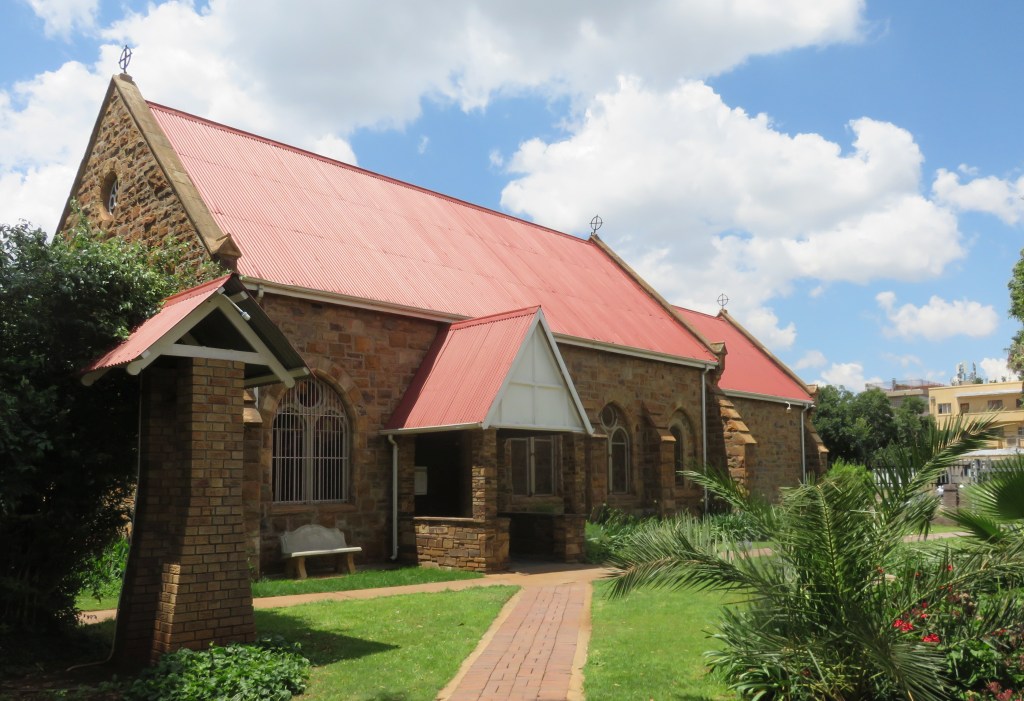 The Anglican Church has a long history in Potchefstroom. A church building was erected already in 1867. It was this building that Emil Holub in his book describes as 'the only significant building of Potchefstroom', he travelled through town in 1872.
The Anglican Church has a long history in Potchefstroom. A church building was erected already in 1867. It was this building that Emil Holub in his book describes as 'the only significant building of Potchefstroom', he travelled through town in 1872.
 With increasing numbers it became necessary to build a new church. The new church was designed by John George Crone and the builder was Augustus Falconer. The foundation stone was laid in 1890. During construction there was a calamity when the newly build chancel arch collapsed, which led to the resignation of the architect. a local architect, JW Gaisford took over to complete the work. The opening service was held on the 14 June 1891.
With increasing numbers it became necessary to build a new church. The new church was designed by John George Crone and the builder was Augustus Falconer. The foundation stone was laid in 1890. During construction there was a calamity when the newly build chancel arch collapsed, which led to the resignation of the architect. a local architect, JW Gaisford took over to complete the work. The opening service was held on the 14 June 1891.
 Something interesting, for me at least, when looking at the old baptism register I noticed a number of Afrikaans surnames. This was explained by Rev Mark, not everyone agreed at the time when the NHK was formed and preferred to have their children christened in the Anglican Church.
Something interesting, for me at least, when looking at the old baptism register I noticed a number of Afrikaans surnames. This was explained by Rev Mark, not everyone agreed at the time when the NHK was formed and preferred to have their children christened in the Anglican Church.
I just had to find place to also show an example of the many beautiful stained glass windows.
Berlin mission church

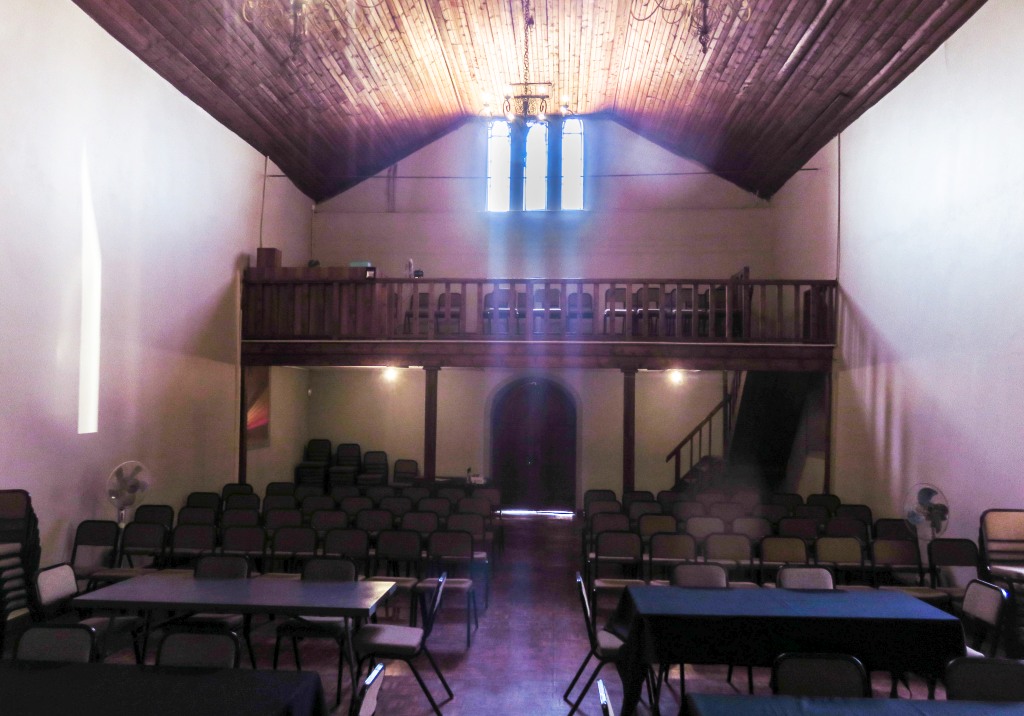 It is not just the church, it is referred to as the Berlin mission complex, consisting of the church, classrooms, the pastorie and a wagon house. It is situated at the corner of Sol Plaatjie and du Plooy street.
It is not just the church, it is referred to as the Berlin mission complex, consisting of the church, classrooms, the pastorie and a wagon house. It is situated at the corner of Sol Plaatjie and du Plooy street.
The Berlin Mission Society was approached in 1872 to send a missionary to Potchefstroom. Pastor Moschütz took on the task and despite ill-health immediately started building a house to serve as the rectory and included a class room. He completed that in 1873 and moved in. The task of building a church could begin. The pastor started collecting building material, but before he could start building he died. That was on the day his successor, Pastor Bruno Köhler, arrived during 1874.
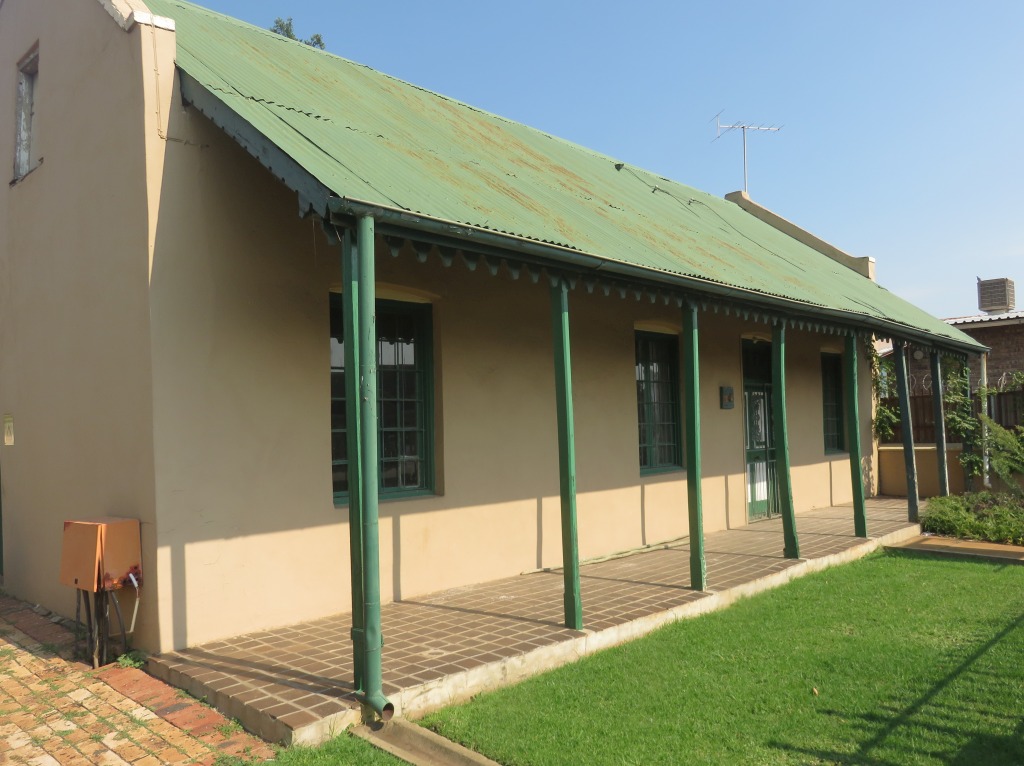
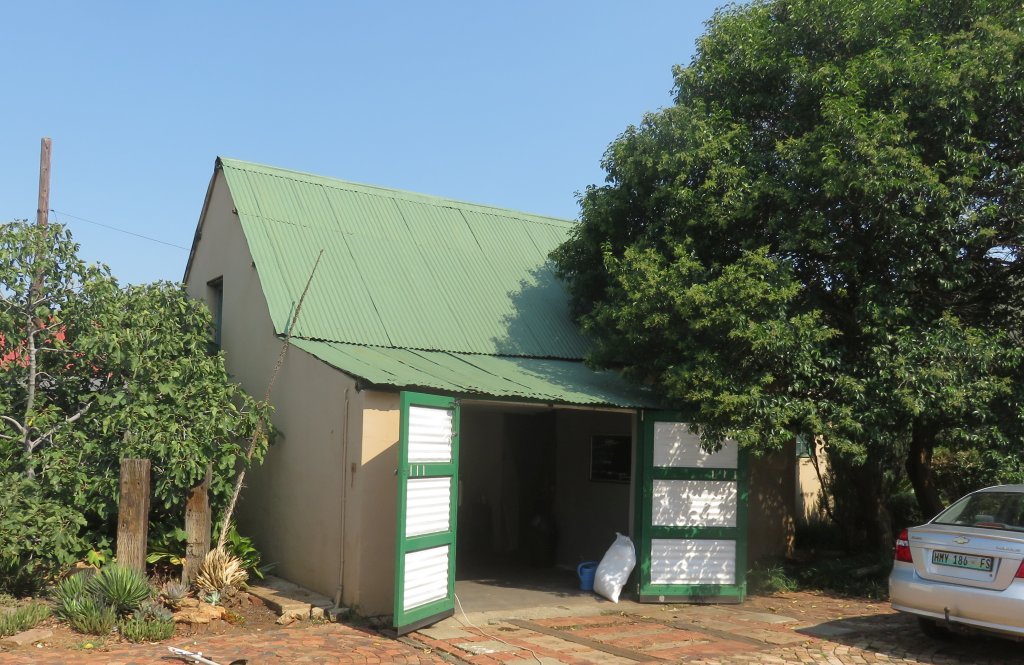 The corner stone was laid in 1875. His congregation consisted of Basotus, Matabele, Hottentots, Griqua and also some Europeans. There was resistance in town to the erection of the church, but the Pastor persisted. And in November 1877 the church was inaugurated.
The corner stone was laid in 1875. His congregation consisted of Basotus, Matabele, Hottentots, Griqua and also some Europeans. There was resistance in town to the erection of the church, but the Pastor persisted. And in November 1877 the church was inaugurated.
I have tried to piece together how the in individual buildings came about. There is a sketch in rev 4 that shows the complex in the 19th century. It is noticed that the property extended further along Sol Plaatjies street than what it is now. The picture on the left shows the rectory built in 1873/74 by Pastor Moschütz. It served as a living quarter and for the missionary and included a class room. This building was later extended to the back of the property. On the sketch is, what looks like, a stable on the extension of the property. The picture on the right shows, which I think, was the stable and wagon house. It was constructed later when the property was divided, most likely early in the 20th century. On the sketch one can also see a flat roofed building next to the present gate. This must have been the wagon house in those days.
With time there were enough German Lutherans in the area that a German congregation could be formed in 1883, their minister was Pastor Windisch. Both church communities used the same church, but separately. The coloured congregation did build their own church in1962 closer to their home in the location. And the German community had their church build 1964 in Bailliepark. Thus the mission church became vacant. After some changes of ownerships it eventually was taken on as a restoration project by the Simon van der Stel foundation and the SA German cultural society.
Since than it has changed ownership again and is now used by a Mission Society.
The Synagogue

 Potchefstroom had a large Jewish community, that is judging by the size of the Jewish graveyard in the cemetery.
Potchefstroom had a large Jewish community, that is judging by the size of the Jewish graveyard in the cemetery.
The first Jews already arrived with the Voortrekkers in 1838. One of them mentioned by name in the sources was Asher Singer. He was a tailor and it is said made the wedding suit for President MW Pretorius. Jews arrived in larger numbers not only in Potchefstroom, but the whole of South Africa, during the 1870's from Lithuania and Latvia. That was because of severe anti-Semitism in those parts of the Russian empire.
 The first synagogue was built in 1897 in du Plooy street. The corner stone for a new synagogue was laid on 17 September 1920. This one served the community until 2000, in that year the synagogue was de-consecrated and the buildings sold.
The first synagogue was built in 1897 in du Plooy street. The corner stone for a new synagogue was laid on 17 September 1920. This one served the community until 2000, in that year the synagogue was de-consecrated and the buildings sold.  This was a consequence of a decline in the Jewish population. In 1945 there were 145 Jewish families living in Potchefstroom, in 1988 this number was down to 18 families, 1992 it was 15 and 2019 it was only six Jewish people living in Potchefstroom.
This was a consequence of a decline in the Jewish population. In 1945 there were 145 Jewish families living in Potchefstroom, in 1988 this number was down to 18 families, 1992 it was 15 and 2019 it was only six Jewish people living in Potchefstroom.
The building now houses the Potchefstroom Academy, a learning institution offering full time and correspondence courses in diverse subjects such as photography, financial accounting, hairdressing, aromatherapy, office administration and many more.
The synagogue itself has been converted to a lecture hall, without changing very much, the original benches still in use and the altar (not sure this is the correct term) kept, just hidden by a projection screen. The building is very well maintained.
Most information for this chapter was obtained from this website about the Jewish population of Potchefstroom.
Cemeteries
Old Cemetery
I am here referring to the cemetery in Alexander Park on the corner of Nelson Mandela drive and Piet Bosman street. It is not the oldest in Potchefstroom. The first cemetery was in the area where the university is, the area is completely build over now , it is not known what happened to the graves. It is generally believed that they are still there.

 The most prominent grave in the Alexander Park cemetery is that of Mathinus Pretorius, already shown higher up. Other graves of interest, there are a number. Dirk van der Hoff, see picture, he was the theologian who had been called from Holland to help establish a church independent from the Cape NG synod. The inscription translated reads as follows, semicolon indicating a line break: in memory; of the very revered and; learned mister Dirk; van der Hoff born at; Dordrech in the Netherlands; in his life teacher of; the Nederduitsch Hervormde; congregation of Potchefstroom; Z.A.Republic; at the age of 67 years; 1 month and 7 days. I had to call on my friend, Frans, to help with some of the difficult words. Very strange in the text is the use of capital letters, I, nor Frans, have any explanation.
The most prominent grave in the Alexander Park cemetery is that of Mathinus Pretorius, already shown higher up. Other graves of interest, there are a number. Dirk van der Hoff, see picture, he was the theologian who had been called from Holland to help establish a church independent from the Cape NG synod. The inscription translated reads as follows, semicolon indicating a line break: in memory; of the very revered and; learned mister Dirk; van der Hoff born at; Dordrech in the Netherlands; in his life teacher of; the Nederduitsch Hervormde; congregation of Potchefstroom; Z.A.Republic; at the age of 67 years; 1 month and 7 days. I had to call on my friend, Frans, to help with some of the difficult words. Very strange in the text is the use of capital letters, I, nor Frans, have any explanation.
 Christian O.Woite was executed by the Boers during the 1st Boer War. His story is told in Ref 8. He was from Prussia, one of the countries in Germany, had been living in the Cape for a few years before coming to Potchefstroom. Here he practised as a healer and seemed to be fairly successful and had become well known in the area. On the 8th of January 1881 he and his son, Wilhelm, of 19 were brought before the war council of the Boers, being accused of spying for the British. The trial was a secret trial, thus the exact nature of the charge and the evidence lead are not known. Christian was sentenced to be executed and his son acquitted. Only 2 hours were allowed to prepare for the execution. Just enough time to allow his wife to say good bye and for the local pastor of the Berlin Mission church, B.Kohler, to lead him in prayer. He left behind a wife and nine children.
Christian O.Woite was executed by the Boers during the 1st Boer War. His story is told in Ref 8. He was from Prussia, one of the countries in Germany, had been living in the Cape for a few years before coming to Potchefstroom. Here he practised as a healer and seemed to be fairly successful and had become well known in the area. On the 8th of January 1881 he and his son, Wilhelm, of 19 were brought before the war council of the Boers, being accused of spying for the British. The trial was a secret trial, thus the exact nature of the charge and the evidence lead are not known. Christian was sentenced to be executed and his son acquitted. Only 2 hours were allowed to prepare for the execution. Just enough time to allow his wife to say good bye and for the local pastor of the Berlin Mission church, B.Kohler, to lead him in prayer. He left behind a wife and nine children.
Another source that has come to my attention about the death of Christian Woite, it appeared in a New Zealand newspaper and is based on a report by the Referent Posselt of New Germany in Natal: push here. That article differs in some of the details, but overall reports the same event. Rev. Posselt was a missionary of the Berlin Mission society active in New Germany in Natal. It is stated in the article that Christian and his family had lived in New Germany before moving to Potchefstroom. The report also revealed why Christian was accused of spying. He had written a letter to one of the British officers in Potchefstroom about the plan of the Boers to declare a new republic. This letter was left behind in a hotel room when the British vacated and moved to the fort. It was found by the Boers when they took occupation of some rooms in the hotel.
 And now, I found another source which tells the story somewhat differently: . Here Christian was a tailor and the letter was found with Major Clarke when they surrendered. This reference also contains the text of the letter, which I will reproduce here with the proviso that I am not certain of its authenticity.
And now, I found another source which tells the story somewhat differently: . Here Christian was a tailor and the letter was found with Major Clarke when they surrendered. This reference also contains the text of the letter, which I will reproduce here with the proviso that I am not certain of its authenticity.
 I have searched the graveyard for Christian Woite's grave, to no avail, thus no picture.
I have searched the graveyard for Christian Woite's grave, to no avail, thus no picture.
Something interesting I found in the Internet was a court document wherein Anna Woite was declared the guardian of her children. I am not sure about the background to this. I think what it means is that women in those days were not automatically guardians of their children, the normal case was that some male relative would be appointed to this role. The document translated reads as follows (semi colon indicates line break): Orphan Court, Transvaal; Appointment as guardian; with this order; Anna Woite geb Blase; has been appointed as guardian; of: William Woite; Maria Woite; Elizabeth Woite; Anna Woite; Emily Woite; Herman Woite; Heinrich Woite; Pauline Woite; Eliza Woite; all children of her and her late husband's Christian Woite; ZAR 29 September 1881.
Potchefstroom cemetery
It's big, we had a walk around there, but only covered the older sections. Here are some of the significant graves, that is graves where I was able to pick up some of the background to the name on the grave stone.
 Bruno Köhler, we met him before, he was the second missionary that came to lead the Berlin Mission station in Potchefstroom. As a sideline he also acted as the minister of the German Lutheran congregation. The stone reads, translated, semicolon indicating line breaks: Good Bye; here rests in God; Pauline Elisabeth Köhler; ne Wauer; born 22 Nov 1848; died 21 Dec 1925; and; Missionary C.A.Bruno Köhler, born 18 Sept 1842; died 25 Nov 1931.
Bruno Köhler, we met him before, he was the second missionary that came to lead the Berlin Mission station in Potchefstroom. As a sideline he also acted as the minister of the German Lutheran congregation. The stone reads, translated, semicolon indicating line breaks: Good Bye; here rests in God; Pauline Elisabeth Köhler; ne Wauer; born 22 Nov 1848; died 21 Dec 1925; and; Missionary C.A.Bruno Köhler, born 18 Sept 1842; died 25 Nov 1931.

 Jan Lion-Cachet, he was a well respected professor at the theological school of the Gereformierde Kerk in Potchefstroom. I don't need to go into details of his life, there is lots of information in Wikipedia and other sites on the internet.
Just something I found amusing, his style of lecturing was very unusual and made him very well liked by the students. Very often he would lecture with his feet on the desk, constantly puffing away on his pipe with his dog on the side. He lived from 1838 to 1911.
Jan Lion-Cachet, he was a well respected professor at the theological school of the Gereformierde Kerk in Potchefstroom. I don't need to go into details of his life, there is lots of information in Wikipedia and other sites on the internet.
Just something I found amusing, his style of lecturing was very unusual and made him very well liked by the students. Very often he would lecture with his feet on the desk, constantly puffing away on his pipe with his dog on the side. He lived from 1838 to 1911.
Concentration camp
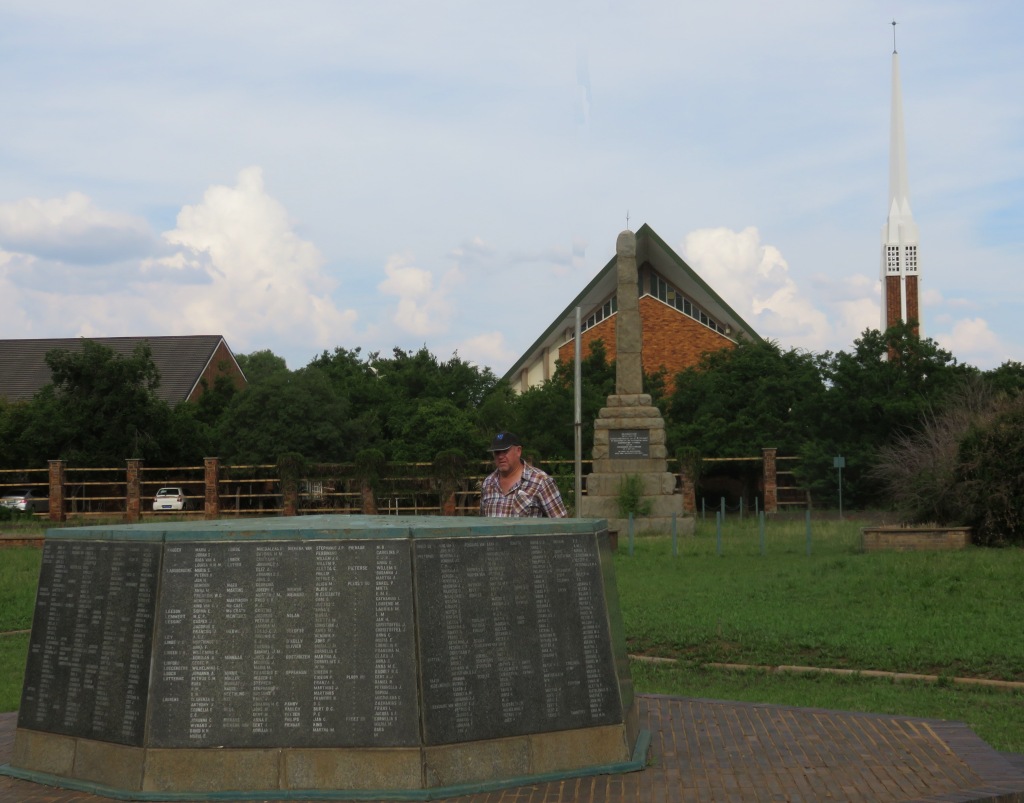 During the Anglo-Boer war a concentration camp was established in Potchefstroom to collect the woman, children and old people displaced from the farms. When exactly the camp started is not known, it was certainly in operation in October 1900. During February 1901 it was turned over to civilian administration.At that time 4000 refugees were in Potchefstroom, about half in the camp and the other half in vacant houses in the town.
During the Anglo-Boer war a concentration camp was established in Potchefstroom to collect the woman, children and old people displaced from the farms. When exactly the camp started is not known, it was certainly in operation in October 1900. During February 1901 it was turned over to civilian administration.At that time 4000 refugees were in Potchefstroom, about half in the camp and the other half in vacant houses in the town.
Between June and December 1901 the camp suffered a major epidemic of measles and influenza leading to many fatalities. Over the two years of the existence of the camps 1141 people, mostly children, died due to disease. All the names are inscribed at the memorial.
The camp existed long after peace was declared. That was mainly because the houses in town had to be vacated because of returning residents, the difficulty of finding a home for people that had no place to return to and other camps in the district closing down.
die Oude Dorp
 The Oude Dorp (the old town) was situated about 7 miles north along the Moiriver. Apparently nothing is left of the place, anything left standing was demolished after the place was vacated. Nearby is a old farmhouse dating from those days (see picture).
The Oude Dorp (the old town) was situated about 7 miles north along the Moiriver. Apparently nothing is left of the place, anything left standing was demolished after the place was vacated. Nearby is a old farmhouse dating from those days (see picture).
In the literature it is mentioned that there is an old grave yard. I have to visit the area again and explore a bit.
 And that we did, no traces of the oude dorp were found. There was an old store on the farm Anderland, dating back to the 2nd half of the 19th century. Inspection showed it to be build of sun-dried mud bricks on a foundation of natural stones.
And that we did, no traces of the oude dorp were found. There was an old store on the farm Anderland, dating back to the 2nd half of the 19th century. Inspection showed it to be build of sun-dried mud bricks on a foundation of natural stones.

 An other interesting 'discovery' on this farm was the irrigation channel coming all the way from Gerhard Minnebron. It was dug by Piet Bezuidenhout (most likely not single handed by himself) between 1895 and 1900. At this point it was 15km in length and finished here. The channel is not in use, it was replaced by a new, concrete-lined channel in 1962. The farmer has cleared some of the channel to be used as a foot path. The start of the channel is shown on the page about Gerhard Minnebron.
An other interesting 'discovery' on this farm was the irrigation channel coming all the way from Gerhard Minnebron. It was dug by Piet Bezuidenhout (most likely not single handed by himself) between 1895 and 1900. At this point it was 15km in length and finished here. The channel is not in use, it was replaced by a new, concrete-lined channel in 1962. The farmer has cleared some of the channel to be used as a foot path. The start of the channel is shown on the page about Gerhard Minnebron.
Potchefstroom Agricultural College

 To help agriculture in the Transvaal to get going again it was decided by the department of agriculture to establish a experimental farm at Potchefstroom. For that purpose some of the commons were used to lay out the farm. That was just after the Anglo Boer war in 1902, during 1903 a post graduate student, Alex Holm, arrived from the UK to take over as manager.
To help agriculture in the Transvaal to get going again it was decided by the department of agriculture to establish a experimental farm at Potchefstroom. For that purpose some of the commons were used to lay out the farm. That was just after the Anglo Boer war in 1902, during 1903 a post graduate student, Alex Holm, arrived from the UK to take over as manager.
And in 1909 an agricultural school was established with Alex Holm as the first head. It started in that year with 24 students. In 1939 it was converted to the Agricultural College offering courses to post matric students leading to a diploma.
 The buildings from the early days still existing are the administration building (1907) and the Selborne Hall. The Selborne Hall was build in two stages, 1909 and the then expanded in 1913. None of these buildings are still in use and essentially left to the elements.
The buildings from the early days still existing are the administration building (1907) and the Selborne Hall. The Selborne Hall was build in two stages, 1909 and the then expanded in 1913. None of these buildings are still in use and essentially left to the elements.
Selborn Hall is the most interesting. there was a fire in the library that partially destroyed the library, but lots of the books and publications are still there but completely abandoned. Other buildings are still in use, such as the Alex Holm hall, the student accommodation, the class room complex and the administration.

 The experimental farm was turned into an agricultural research institute. Research is still going on there, but certainly not as much as in the earlier days. We inspected some of the green houses. Not all the compartments are functional, apparently some of the air conditioning units are out of order.
The experimental farm was turned into an agricultural research institute. Research is still going on there, but certainly not as much as in the earlier days. We inspected some of the green houses. Not all the compartments are functional, apparently some of the air conditioning units are out of order.
I didn't get a good overview of what is happening out on the fields, but did get to a field of very healthy looking cabbage plants, most likely there for seed production.
Interesting Events in and around Potch
Boer civil war
That was October 1862, an exchange of cannon fire between two opposing Boer forces, the one under the chief commandant Schoeman and the other one under Paul Kruger. The background to this was the confusion caused by president M.Pretorius's leave of absence to be the president of the Free State in order to achieve unity between the two republics. There wasn't much enthusiasm in the ZAR (Zuid Afrikaanse Republik, basically the Transvaal) and also neither in the Free State. The confusion in the ZAR led to two opposing groups forming, actually its much more complicated than that, best is to read it up in Ref 2.
Schoeman was moving towards Potchefstroom with 350 men and one canon. Paul Kruger was in pursuit and had 850 men under arms (in Ref 3, it mentions 1800) and three canons.
 Schoeman had taken position in town around Kerk- and Spruit street, Kruger initially placed himself around what is now Cachet park. Realising that he could become encircled by Schoeman's men he moved over to a small hill which is still called Vegkoppies and the street at it Vegkoppies street. From there he could much better observe what was going on around him.
Schoeman had taken position in town around Kerk- and Spruit street, Kruger initially placed himself around what is now Cachet park. Realising that he could become encircled by Schoeman's men he moved over to a small hill which is still called Vegkoppies and the street at it Vegkoppies street. From there he could much better observe what was going on around him.
There were a few skirmishes which did not result in any decision. But over night Schoeman and his men made for the Free State. The result of all this was one killed, 8 wounded and the loss of a canon from Schoeman's side and 2 men wounded on Krugers side.
The picture was taken on kanon kop, where Kruger did place his canons. Not much to be seen, it is a very low hill.
References
Ref 1.: Standard Encyclopedia of Southern Africa, Nasou Limited, 1974
Ref 2.: TV Bulpin, Lost Trails of the Transvaal, Thomas Nelson and Sons, 1965
Ref 3.: Herald, Potchefstroom en Ventersburg, 1838-1988 Potchefstroom, commemorative issue,
Ref 4.: Dr.Lennie Gouws, Stories van/of Potchefstroom, 2018
Ref 5.: Eeufees 1917-2017-NG Gemeente Potchefstroom-Mooirivier
Ref 6.: Arie Kuijers, Historiese Geboue in Potchefstroom, 1984
Ref 7.: Geoffrey Jenkins, A Century of History, published by the Potchefstroom Herald, 1938
Ref 8.: The Diary of G.F.Austin, CUM Books, 1981
Ref 9.: Methodists celebrate 127 years in Potchefstroom, article in the Potchefstroom Herald, 3 Oct 95
Ref 10.: "Ons Kerk Album van Hollandsche Kerken en Leeraren", publisher: unknown, printed in the 1920's